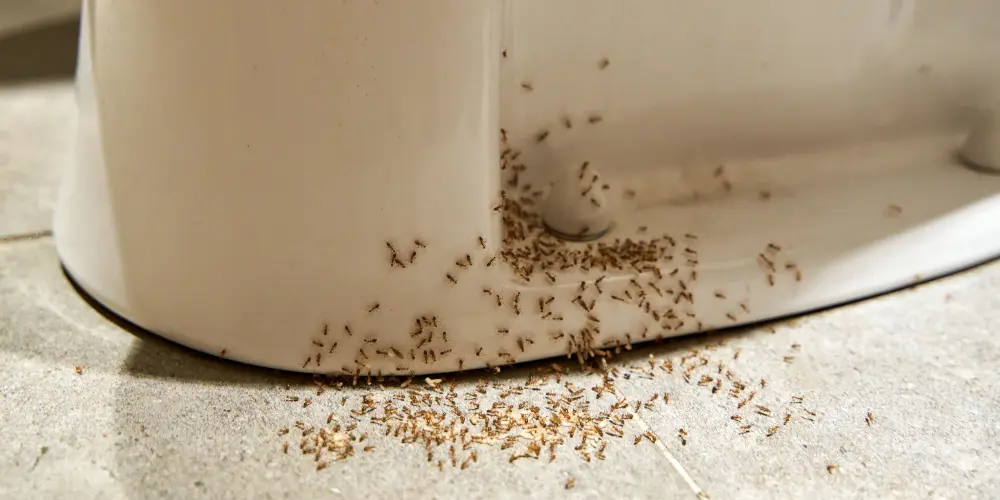Water is scarce during Orange County’s hot, dry summers. Imagine you’re a tiny ant whose only access to H2O comes from bathroom plumbing. From an ant’s viewpoint, your moist bathroom is an oasis in the Sahara.
This explains the ants in your bathroom, with its abundant water sources like sinks, showers, and toilets. Plus, bathrooms tend to be warm, making them an ant’s paradise.
Now that you’ve invited them in, how can you encourage them to leave? And without harmful chemicals?
Chemical repellents can pose health hazards to your family and pets. They can also harm the environment.
Non-chemical methods are a safer and eco-friendly way to deal with ants, and there’s no risk of noxious chemicals entering your home.
Identifying the Ant Species
The ants that commonly invade Orange County bathrooms include:
- Argentine Ants: These are medium-brown, about 1/8 inch (2-3mm) long. They’re prolific breeders and thrive in wet areas.
- Ghost Ants: Smaller than Argentine ants, these are light brown or transparent. They trail along pipes and electrical wires to get to your bathroom.
- Pharaoh Ants: These yellowish-red ants are known for their minuscule size, just 1/16 inch (2mm) long. They’re attracted to dirty or moist bathrooms.
- Carpenter Ants: Black or dark brown and about 1/2 inch (12 mm) long, these large ants prefer wet, decaying wood in your bathroom’s walls.
- Velvety Tree Ants: Black and about 1/4 inch (6mm) long, they prefer to nest in the moist soil of potted plants, which can then lead them into your bathroom.
Nesting and feeding habits vary by species, but some tried and true natural repellents and preventive measures are effective against them all.
Natural Deterrents & Prevention
Nature gives us a cornucopia of substances that ants avoid.
Essential Oils
Essential oils have been used for generations as a natural way to repel insects. As a bonus, most humans enjoy their scent.
- Peppermint Oil: Known for its strong, minty aroma, it will discourage ants and other pests.
- Tea Tree Oil: Its potent, medicinal aroma makes it another excellent choice for ant invasions.
- Lemon Eucalyptus Oil: The sharp, citrusy smell keeps ants away and leaves a fresh scent.
- Clove Oil: Clove oil has a spicy fragrance and contains eugenol, a component that ants find particularly unpleasant.
- Cinnamon Leaf Oil: Distinct from the ground spice, cinnamon leaf oil is a powerful repellent for ants and other insects.
Dilute these oils with water in a spray bottle, apply the solution directly to areas where ants enter or congregate, or soak cotton balls with a few drops of the oil and place them strategically in your bathroom.
Always keep essential oils away from pets and children, and test them on a small area to ensure they won’t damage surfaces or fabrics.
Vinegar & Water Solution
- Mix equal parts of vinegar and water in a spray bottle.
- Add a few drops of citrus essential oil to mask the vinegar smell.
- Spray the solution along ant entry points like doorways, windowsills, and cracks in walls or floors.
Bonus Tip: Use the solution to clean bathroom surfaces. It will discourage ants, disinfect, and leave a fresh scent.
Diatomaceous Earth
Diatomaceous earth (DE) is an organic powder made of fossilized diatoms, a hard-shelled algae. To insects like ants, it’s like walking on shards of glass.
It pierces their exoskeletons so that they dehydrate and die. Despite this deadly effect on ants, DE is non-toxic to humans and pets.
Sprinkle a thin layer of food-grade DE along ant trails, near entry points, and where you’ve seen ant activity. Avoid using it in damp areas; moisture limits its effectiveness.
Baking Soda & Sugar Mix
Sugar acts as bait in this combination, while baking soda disrupts the ants’ digestive systems.
- Mix equal parts of baking soda and sugar into a small container.
- Lightly sprinkle the mixture near ant trails, entry points, or corners of the bathroom.
- Reapply as necessary, especially after cleaning the bathroom or if the mixture becomes damp.
Caution: Although baking soda is generally safe, it should still be kept out of reach of pets and children who may mistake the sweetened mix for food.
Coffee Grounds
Ants don’t like the smell of coffee. Scatter used coffee grounds in garden areas to prevent ants from entering your home.
Cornmeal
Although non-toxic (except in your Aunt Edna’s pernicious cornbread recipe), cornmeal can serve as ant control. Spread it around areas where you notice ant activity. The ants will consume it, but they can’t digest it.
Maintaining Cleanliness
Regular cleaning is a crucial preventative measure. Wipe up standing water, clear any hair or debris from drains, and mop up spills immediately to keep ants at bay.
Add a few drops of lemon juice or vinegar to your DIY cleaners to boost their repellent properties.
Sealing Entry Points
To identify and seal common entry points for ants, observe the areas where ant activity is most frequent. Ants can enter through the smallest gaps, so it’s essential to identify all potential entry points:
- Check windows and doors: Look for gaps between the frames and the walls. Use weather stripping or caulking to seal off these areas.
- Inspect pipes and wire entry points: Anywhere a cable or pipe enters your house can be a superhighway for ants. Seal these openings with caulk or expanding foam.
- Look for cracks in the foundation: Small fissures can be an open invitation for ants. These cracks should be filled with concrete patching or sealant.
- Search for gaps in walls or ceilings: Any crack or hole in your walls or ceilings can be a potential ant entrance. Repair any damage with joint compound or plaster.
- Evaluate kitchen and bathroom fixtures: Spaces around sinks, bathtubs, and appliances can also be gateways for ants. Seal off any gaps with silicone caulk.
Attracting Ant Predators
Natural ant predators include:
- Spiders: Various spider species can naturally control ant populations, especially when their webs are near ant trails.
- Birds: Many species, like sparrows, wrens, and robins, feast on ants. Encourage these birds to visit your garden by providing birdhouses and water sources.
- Lizards: Common in Orange County, lizards like geckos are efficient ant predators.
- Frogs and Toads: Amphibians like frogs and toads eat ants and can be a helpful part of a garden ecosystem.
- Insect Predators: Other insects like ladybugs, beetles, and predatory flies also hunt ants as part of their diet.
- Anteaters: These mammals are the ultimate ant control solution. Get one for your personal zoo! 🙂
Dealing with Large Ant Colonies
Take prompt action against any significant ant infestation.
- Locate the Colony: Observe the ant trails to determine where the ants enter the nest.
- Bait Systems: Deploy ant baits to be carried back to the nest. This delivers the poison to the queen.
- Boric Acid: Mix boric acid with a sweet lure and place it near the trails. This concoction acts slowly, allowing worker ants to carry the poison to the colony.
- Diatomaceous Earth: Food-grade DE can be used to target larger colonies. Apply it generously around the nest entrance.
- Professional Pest Control: If the colony is extensive or hard to locate, experts can employ more potent substances and techniques unavailable to the public.
- Warning: Exercise caution when dealing with large colonies, which may become aggressive. Always prioritize safety and consider the environmental impact of your methods.
Frequently Asked Questions about Ants in Bathrooms
Q: Are chemical ant repellents safe to use in the bathroom?
A: We don’t recommend them. Chemical ant repellents may pose health risks and have negative environmental impacts.
Q: What essential oils are effective against ants?
A: Peppermint, tea tree, and citrus oils are known for their ant-repelling properties.
Q: Is diatomaceous earth safe for pets and humans?
A: Food-grade diatomaceous earth is generally safe for pets and humans when used as directed.
Q: When should I seek professional help for ant infestations?
A: If the ant infestation is significant, persistent, or poses a threat, we advise consulting a professional pest control service.
Q: Can ants damage bathroom fixtures or plumbing?
A: While ants themselves don’t typically damage bathroom fixtures or plumbing, large infestations can exploit existing weaknesses in the structure for nesting, which may indirectly worsen the problem.
Q: Are specific types of ants attracted to bathrooms more than others?
A: Moisture-loving ants, such as carpenter ants and pharaoh ants, are commonly attracted to bathrooms due to the high humidity and potential for water accumulation.
Q: How can I tell if an ant infestation in my bathroom is serious?
A: If you notice large numbers of ants consistently, especially carpenter ants, which can cause structural damage, or see them emerging from nests in walls or fixtures, it might be time to call a professional.
Q: How often should I reapply natural ant repellents in the bathroom?
A: You should apply natural ant repellents every week after a cleaning session. Wiping and moisture can dissipate their effectiveness.
Q: What precautions should I take when using DIY ant control methods with children in the house?
A: Always store ant control substances out of reach of children. Don’t use toxic materials. Clearly label all DIY ant traps. Educate children about their purpose and the importance of not touching them.


